 Leading Blog | Posts by Month |
 Leading Blog | Posts by Month |
03.31.20

LeadershipNow 140: March 2020 Compilation
See more on
Posted by Michael McKinney at 09:12 AM
03.30.20

What’s Your Problem?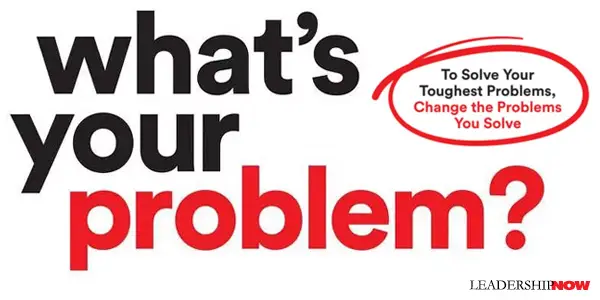
WE HEAR A LOT about reframing, but do we actually do it? True. We get busy, and we start looking for a solution without first analyzing the problem. We want a quick solution so we can move on. And we “solve” the wrong problem. Reframing helps us to avoid this. Reframing helps us to see solutions that we would otherwise not see, as we see the issue from different angles. Sometimes the process of reframing leads us to discover that what we thought was the problem is not really the problem at all. It is a symptom of the problem. Solving for symptoms locks us into a perpetual crisis loop like a hamster on an exercise wheel. We end up with laws and rules that solve nothing because we’re solving the wrong problem. Thomas Wedell-Wedellsborg helps us get a handle on this reframing skill in What's Your Problem?: To Solve Your Toughest Problems, Change the Problems You Solve. “Sometimes,” writes Thomas, “to solve a hard problem, you have to stop looking for solutions to it. Instead, you must turn your attention to the problem itself—not just to analyze it, but to shift the way you frame it. Reframing is not necessarily about the details. It is more about seeing the big picture and having the ability to consider situations from multiple perspectives.” Reframing There are two different ways of reframing a problem: exploring the frame and breaking the frame.
When exploring the frame, you’re looking for aspects of the issue that you might not have considered. “Breaking the frame is when you step away completely from the initial framing of the problem.” It is the more important of the two skills because “if you don’t master it, you will get trapped by the initial framing of the problem.” Thomas provides several examples that help you to see reframing in practice. Reframing, says Thomas, is like a loop off of the straight-line path to a solution. It is “a brief, deliberate redirection that temporarily shifts people’s focus to the higher-level question of how the problem is framed. It results in getting back on the path with a new or improved understanding of the problem.” Problems present themselves in three ways: “an ill-defined mess or pain point, a goal we don’t know how to reach, or a solution someone fell in love with.”
How to Reframe Thomas introduces a method we can use on any problem that we face. No problem is too big or too small. He recommends that we “modify the reframing process to fit the size of the problem.” In other words, you can either use all seven steps in the process or scale it down according to how much time is available. “You don’t necessarily have to stick to the sequence. When solving problems as part of a quick workplace conversation, feel free to jump straight to the particular strategy that seems most promising given the problem at hand.” Complex problems take more time to reframe, but some can be reframed in as little as five minutes. The important consequence of understanding this process is that you become more curious and intentional with problem-solving. You begin to ask questions instead of just jumping to a solution.
Here is a brief overview without all of the insightful and instructive examples: Frame the Problem Look Outside the Frame Rethink the Goal Examine Bright Spots Look in the Mirror Take Their Perspective Research has shown that people focus too much on their own perspective when trying to understand others. Try to disregard your own preferences. Focus only on how they might feel and think. Move Forward Thomas also offers some approaches when dealing with people who resist the process and those who are in denial. What’s Your Problem? is the most thorough and practical book you’ll read on this critical habit of problem-solving and thinking well. Well-illustrated, and full of clarifying examples, he teaches you how to reframe any issue you encounter in either your personal or professional life. On the What’s Your Problem? website, you can find a Reframing Worksheet and Checklist, and other useful downloads. 
Posted by Michael McKinney at 06:20 PM
03.27.20

Restoring the Soul of Business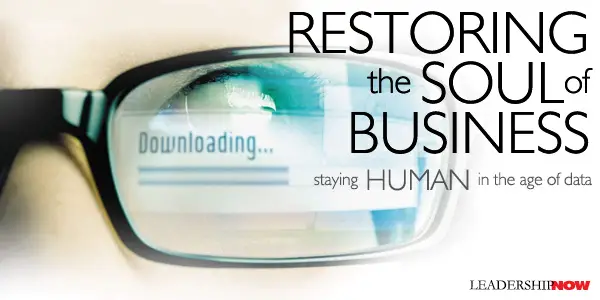
DATA without soul is harmful. Science, math, and data do not excuse us from thinking. Instead, they make it imperative that we learn to think more critically and combine it with our humanness to come to more measured conclusions. The story we create with the data makes all the difference. Rishad Tobaccowala is the chief growth officer at Publicis Group, a global advertising and communications firm. He says that flush with data, we risk losing something more valuable: what’s human. Rishad writes in Restoring the Soul of Business: Staying Human in the Age of Data, that we can have too much math and too little meaning. “Successful individuals and firms can never forget the importance of people, their emotions, the culture of the organization, and what cannot be measured. Successful people and companies combine the story and the spreadsheet, and by doing so, restore the soul of business.” It’s a balance. The 6-I Approach Extracting meaning and accurate insights from data is made better by implementing what Rishad calls the 6-I Approach. Interpret the Data Not all data is alike. “Develop hypotheses, search for patterns, look for outliers, create alternative scenarios to explain the information you’re receiving. Through interpretation you can enrich the data with meaning; you can identify the story it’s telling.” Involve Diverse People “Expand the group that examines the data. When you involve people with various skills and perspectives, you’re likely to receive a richer interpretation.” Interconnect to Larger Trends and Events How does the data relate to what you’re doing or to an emerging trend or a competitor’s product launch? “Making these types of connections helps you take the data one step further, determining if it’s going to have a short-term or long-term impact, if it’s suggesting the end of a trend or the beginning of a new one.” Give it context. Imagine and Inspire Solutions What possibilities does the data ignite? “Rather than allowing the data to limit options and actions, explore the solutions it might inspire. If the numbers show that your product category isn’t doing as well as it once did in Market Z, is there an emerging opportunity because the market still has potential and competition will be reduced because of this data?” Iterate “Data can spawn new and better data. Is there a test you might run based on the information you’ve gathered that can produce more insightful facts and figures?” Ask new questions of the data. Investigate People’s Experiences “In a given organization, you have hundreds or thousands of people with data-relevant insights because in the past—whether while part of your organization or with a previous employer—they experienced something applicable to the current information.” Sometimes new data is just an old story on a new context. Seven Keys to Staying Human Each of these sections is full of practices to help integrate them into our organizations—to make them more human. Talk About the Inconvenient (Tough) Truths Three of the most valuable assets in communicating are the following four-, five-, and six-letter words: data, trust, and intent. “Do you have good data that supports your point of view? Can you be or are you trusted? What is your intent? – i.e., why are you saying what you’re saying? Organizations must encourage trusted, well-intentioned, well-informed people to display this type of candor, no matter what their titles are? Address the Reality That Change Sucks People see change differently and are affected by change differently. “People won’t support and further change unless they perceive how they and their skills fit in. Employees need to see how the change strategy helps them grow, not just the organization.” When we are data-driven we see things in absolutes. Humans are more nuanced than that. Unleash Creativity by Inserting Poetry into the PowerPoint The spreadsheet “is not a clear window to view either the present or the future. Inherently, it’s backward-looking device that jails thinking within its cells. Within many organizations, highly innovative, potentially game-changing ideas are born regularly. Unfortunately, the left-brain environment of these organizations often starves these ideas of oxygen and they don’t survive.” Introduce art into your organization. “Creativity is how we manage our own change.” Recognize That Talent Does Not Work for Companies but Rather Companies Work for Talent Data tends to favor the organization rather than the employee. “Working for talent translates into three developmental actions: helping people create their niche, voice, and story.”
Diversify and Deepen Time Usage It is a mistake to allocate and measure time only in economic terms or numeric ways. The quality of how people spend their time is as important as the quantity of what they produce during that time. To get the most out of time, organizations need to sanction doing less and open spaces to do nothing. Schedule More Meetings Too often meetings are about the spreadsheet side of the business. “The received wisdom of minimizing meetings and only going to ones that create value for you is wrong. More meetings create more opportunities for productive relationships.” Rishad five types of meeting we should be having that are meaningful and relationship-focused. Upgrade Your Mental Operating System Organizations need to put a priority on mental self-improvement. “Provide them with the means and the encouragement to learn continuously—or rather, to learn and unlearn.” Rishad make this important point about balance. When there is balance between the spreadsheet and the story, people are more likely to form their own opinions and be creative. First, there is a need to balance ends and means. If the goal is to achieve a numerical goal at all costs, balance is missing; people will ignore rules and even laws to achieve goals. A second form of balance is recognizing that people have different skills and the company should not force consistency and conformity. Restoring the Soul of Business is a much-needed book. In a world awash in readily available data, we must never forget the story. The story is what makes the data so valuable. That will be the challenge of the future. Data is the commodity. The story differentiates. Rishad writes: My point isn’t to beat up on algorithms—they obviously are crucial in a digital age—but to suggest that if we leave organizational employees to their own devices (pun intended), they will be reactive and biased in their thinking. They won’t consider options beyond their own narrow beliefs; they will see the trends they’re exposed to rather than explore ones on the periphery; and they will fail to consider that their ideas might be wrong or outdated since their screens are confirming their biases. If we put too much trust in algorithms, we are faced with three big risks: “The first is when you forget that a human programmed an algorithm and so it has a built-in bias. Leaving it to itself means you are giving up agency. Second, no algorithm, which is about zeros and ones, can truly capture humans who are variable. Third, if you can add no value to an algorithm, you have no job.” 
Posted by Michael McKinney at 03:54 PM
03.26.20

Leading Thoughts for March 26, 2020
IDEAS shared have the power to expand perspectives, change thinking, and move lives. Here are two ideas for the curious mind to engage with: Bill Welter and Jean Egmon on the difficulty on truly seeing the world as it is: “Paradigms are wonderful shortcuts as we think about the world, but they are deadly if they are not attuned with reality. All of us are bombarded with increasing waves of data and sensory inputs, and whether we realize it or not, we have become increasingly resistant. It’s not so much a case of having to pay attention to the news of the world as it is a case of knowing when to change our filters so that the important stuff comes in.” Source: The Prepared Mind of a Leader: Eight Skills Leaders Use to Innovate, Make Decisions, and Solve Problems The American entrepreneur and investor Sam Altman on persistence and luck: “A big secret is that you can bend the world to your will a surprising percentage of the time—most people don’t even try, and just accept that things are the way that they are. People have an enormous capacity to make things happen. A combination of self-doubt, giving up too early, and not pushing hard enough prevents most people from ever reaching anywhere near their potential. Source: How To Be Successful Look for these ideas every Thursday on the Leading Blog. Find more ideas on the LeadingThoughts index.
Posted by Michael McKinney at 11:19 AM
03.23.20

Why You Shouldn’t Go It Alone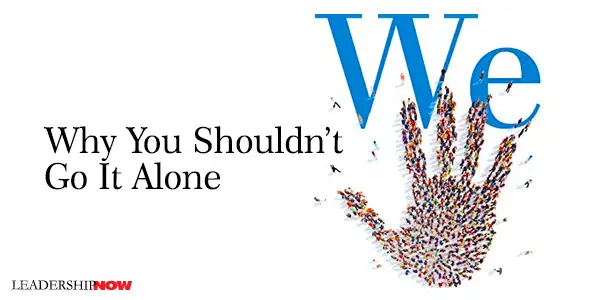
OUR INDIVIDUALISTIC narrative is strong. But it holds us back. Almost anything of importance was accomplished by connecting with others. We can leverage who we are by enlisting others. Eric George, a renowned hand surgeon, entrepreneur, and venture capitalist, shares in We: Ditch the Me Mindset and Change the World that in his field, he frequently sees “a spirit of absolute independence. It’s a mindset that, for whatever reason, makes people ignore the help readily available to them and internalize challenges, headaches, and obstacles.” This also extends to entrepreneurs and aspiring professionals as they “strive to independently achieve while ignoring the crucial relationships and resources that can help them along the way.” Connectedness is not only about us connecting with others but the connections we make for other people. “Connectedness means looking beyond the self and requires us to focus on others and consider how our connectedness can benefit everyone around us.” George identifies and examines six benefits or outcomes of connectedness: Outcome#1: Discovering Our Purpose Discovering how and where to channel our passions, interests, and talents to create shared value that we and others find meaningful. By embracing a wide breadth of diverse people, ideas, and perspectives, we become exposed to many avenues in life, which ultimately help us find where we can succeed and help others do the same. Discovering our purpose (or purposes) in life is sometimes difficult. “Yet by embracing a mindset of connectedness, we can, at the very least, accelerate and improve the process. Rather than passively wait for our purpose to emerge, we uncover the opportunities that lay hidden in the potential connections surrounding us.” Outcome#2: Create Partnerships Connectedness helps us to create partnerships now and opens the door to more connections in the future. “Embracing this mindset helps us find and cultivate truly rewarding and sustainable partnerships from our sincere commitment to learning about, investing in, and survive the interests of others.” Successful people don’t just see others as a means to get things done, but the relationships as an end in themselves. Outcome#3: Supports Perseverance We rarely become successful without resolve and resourcefulness. Connectedness “allows us to recognize the full potential of the opportunities afforded to us and recognize that we can always surmount any obstacle with hard work, the right approach, and access to people who can support us along the way.” Outcome#4: Cultivate Support We don’t know everything, and we don’t know what we don’t know. We need to connect with others who we can trust and “who share our passion and contribute to our purpose. The more connected we become, the more we can find the right people to support our mission in life, and the more we can help nurture their goals and needs.” Truthfully, we never accomplish anything of importance without people helping us along the way. No matter how difficult a surgery or miraculous its outcome, or how smart a business decision, success does not depend on “Me” but on the collective contributions of everyone supporting the organization. Outcome#5: Gain Perspective Perspective expands our minds with the experiences of others. It informs us and connects us with reality. We see the world from a “more informed, objective, and comprehensive point of view. Perspective enables us to fully appreciate life and the people surrounding us.” As a surgeon, connectedness allows him to “cross boundaries my patients self-construct against the external world. It allows me to help them see a world unrestricted by their injury and value what they didn’t lose.” Illuminating other perspectives is a significant part of a leader’s job. Outcome#6: Build Trust When it comes to medical care, trust is vital. George explains that he “must actively build trust through a process that draws heavily on connectedness and the many actions and behaviors that support it.” He continues:
With a mindset of We versus Me, we can see beyond what might divide us and change the world. 
Posted by Michael McKinney at 06:45 PM
03.20.20

Life's Great Question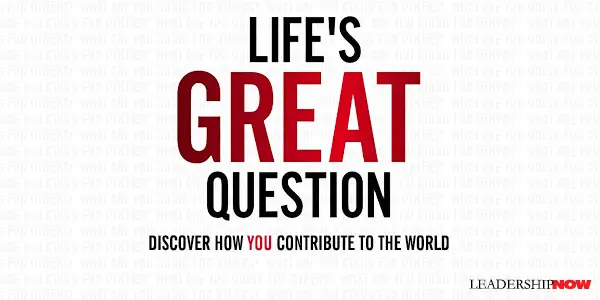
WE ALL want to leave a legacy. We all crave meaning in our lives. It’s not just a millennial thing. Meaning in life comes from the contributions we make beyond the self. Those contributions become your legacy. All of this leads to life’s greatest question: What are you doing for others? Tom Rath addresses this question head-on and presents a path for contribution—a map for creating meaning—in Life’s Greatest Question. While your talents are nature’s best building blocks, they serve the world best when your efforts are directed outward—not inward. Being “anything you want” or “more of who you already are” doesn’t add value to society unless it provides something others need. Simply put, your strengths and efforts must be focused on specific contributions you can make to other people’s lives. Work can be fun and improve our health if we can reframe what we do to how do I help. Reorient your thinking about what you do to how am I serving others—the “humanity of what we do.” But rather than relying on your company to determine your contribution, “figuring out how you can make a greater contribution through your work has to be driven by you.” In other words, “Great jobs are made, not found.”
To that end, Rath introduces the Contribify inventory. It is “designed to help you gain a better understanding of who you are—for the sake of doing more for other people.” Upon taking the inventory, you will come away with the top three areas that have the most potential for your contribution from a list of 12 primary Contributions: Initiating, Challenging, Teaching, Visioning, Connecting, Energizing, Perceiving, Influencing, Organizing, Achieving, Adapting, and Scaling.
Rath makes a very good point regarding the obsession with passion. “Instead of following your passion, find your greatest contribution.” This is one of the critiques of the “follow your passion” advice—that it presumes you are the center of the world, and pursuing your own joy (not service of others) is he objective. I have found that those who leave a lasting mark on the world, in contrast, are always asking what they can give.Life’s Great Question leaves you with a lot to think about and a structured way to go about it. It provides language to what is often a very nebulous exercise. 
Posted by Michael McKinney at 03:33 PM
03.19.20

Leading Thoughts for March 19, 2020
IDEAS shared have the power to expand perspectives, change thinking, and move lives. Here are two ideas for the curious mind to engage with: Erik Larson commenting on Winston Churchill’s belief that leaders should make people feel “loftier, stronger, and, above all, more courageous:” “Recognizing that confidence and fearlessness were attitudes that could be adopted and taught by example, Churchill issued a directive to all ministers to put on a strong positive front. ‘In these dark days the Prime minister would be grateful if all his colleagues in the Government, as well as high officials, would maintain a high moral in their circles; not minimizing the gravity of events, but showing confidence in our ability and inflexible resolve to continue the war till we have broken the will of the enemy to bring all Europe under his domination.’” Source: The Splendid and the Vile Jared Diamond on dealing with a crisis: “Typically when one is first plunged into a state of crisis, one feels overwhelmed by the sense that everything in one’s life has gone wrong. As long as one remains thus paralyzed, it’s difficult to make progress dealing with one thing at a time. Hence a therapist’s immediate goal in the first session—or else the first step if one is dealing with an acknowledgment crisis by oneself or with the help of friends—is to overcome that paralysis by means of what is termed ‘building a fence.’ That means identifying the specific things that really have gone wrong during the crisis, so that one can say, ‘Here, inside the fence, are the particular problems in my life, but everything else outside the fence is normal and OK.’ Often, a person in crisis feels relieved as soon as he or she starts to formulate the problem and to build a fence around it. The therapist can then help the client to explore alternative ways of coping with the specific problem inside the fence. The client thereby embarks on a process of selective change, which is possible, rather then remaining paralyzed by the seeming necessity of total change, which would be impossible.” Source: Upheaval: Turning Points for Nations in Crisis Look for these ideas every Thursday on the Leading Blog. Find more ideas on the LeadingThoughts index.
Posted by Michael McKinney at 09:49 AM
03.16.20

Leading with Gratitude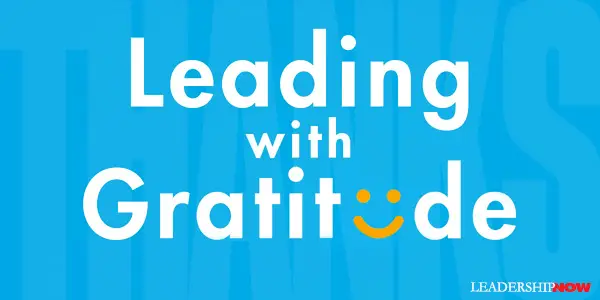
GRATITUDE increases our leadership effectiveness as drives out fear and blame, gives meaning and confidence to all, and boosts productivity. We all know this, yet still, we don’t place as much emphasis on gratitude as we should. We withhold gratitude when we should be expressing it not just for their good but for our own good as well. Gratitude is more than saying thank you. It goes beyond nice. It is an approach to life. Adrian Gostick and Chester Elton say gratitude is “one of the most misunderstood and misapplied skills in business.” When it is genuine and specific, it is the “easiest, fastest, and cheapest way that managers can boost performance and employee engagement.” In Leading with Gratitude, the authors uncover what holds us back from showing gratitude and what we can do about it. They begin by taking a look at the seven most common reasons we avoid showing gratitude. They call them the Ingratutide Myths: fear is the best motivator, people want way too much praise these days, there’s just no time, I’m not wired to feel it, I save my praise for those who deserve it, it’s all about the benjamins, and they’ll think I’m bogus. They debunk each of these with stories and studies. I’m Not Wired That Way We’ve all probably had a few of these myths run through our minds from time to time, but I want to call out one of the myths: I’m not wired to feel it. While we are born with predispositions—warmer or colder, more sensitive to positive or negative circumstances—they are not life sentences. Gratitude, like other character traits, is a matter of choice. We should have developed it from example in our youth, but as we know, that doesn’t always happen. But it is learned. Through practice, we can wire our brains to express gratitude. It becomes a matter of choosing to move beyond our comfortable predisposition towards an approach to life that better serves us as leaders. Seeing and Expressing The last two sections of the book focus on four ways of seeing and four ways of expressing gratitude. Seeing is about awareness. The best leaders know how people contribute and actively look for reasons to express gratitude. It is about seeing good things happening and then expressing heartfelt appreciation for the right behaviors. On the flip side, managers who lack gratitude suffer, first and foremost, from a problem of cognition—a failure to perceive how hard their people are trying to do good work—and, if they’re encountering problems, what they are. These ungrateful leaders suffer from information deficit. Other practices for seeing include assuming positive intent (seeing people as trying to do well), walking in their shoes (understanding the challenges your people are experiencing), and looking for small wins (motivates us for the next step). Expressing, of course, is how to express gratitude. We all need regular feedback. “Timeliness of gratitude communicates that a leader is paying attention, and that giving credit when it’s due is a priority in his busy world.” Like ripe bananas, gratitude does not keep. The closer to an achievement a leader expresses her appreciation, the better. When it comes to expressing, tailor it to the individual. People have different motivators. Giving gratitude helps reinforce the organization's core values. “Gratitude offers an opportunity to put the flesh of specificity on the bones of core values.” Encourage peer-to-peer gratitude. It demonstrates support and builds bonds. “When employees are grateful to each other, they affirm positive concepts typically values in their colleagues, such as trustworthiness, dependability, and talent.” Living Gratefully When we begin to practice gratitude, the goal is to live gratefully—to make it part of who we are. Gratitude then extends to everyone in our lives. It is not just something we do at work to increase productivity, but we take it home and express it to those people that mean the most to us. If we practice gratitude with all the people in our lives, we’ll find that they respond just as well as our employees. When we give our family, friends, and all those we encounter a lift, we also give ourselves more moments of joy. One of the great ironies of personal relationships is that we so often take those who mean the most to us for granted. Adrian Gostick and Chester Elton share example after example of the often creative ways that leaders and organizations that are doing it right show gratitude. We can all begin to live life more gratefully and receive positive results that exceed our efforts. 
Posted by Michael McKinney at 11:44 PM
03.13.20

How to Find Your Edge
WE’VE HEARD that hard work is the secret to success. But all too often we see that hard work is not enough. What then? We need an edge. Laura Huang explains just how to gain that advantage in her insightful and encouraging book, Edge: Turning Adversity into Advantage. “Certain people seem to be endowed with a unique advantage in which they can execute faster and better and get the things they need, because they are positioned in such a way that others help them move forward. You can create your own edge and open doors—wide-open doors—for yourself.” Having an edge makes hard work go further. Those that have an edge, Enrich, Delight, and Guide to make their Effort go further. We must put in the work, but “when you create an edge, you create tailwinds that help you capitalize on your hard work more effectively.” We all face biases, prejudice, and harmful (to us) perceptions and attributions. But these can be the key to overcoming the adversity and roadblocks we face. “For most of you,” she writes, “it will be about positioning yourselves as an antidote to stereotypes, which will allow you to guide the perceptions of others, delight others, and ultimately will result in others seeing the unique value you can provide.” Enrich Huang begins with Enrich because it is the foundation of our edge. To do this, we begin by finding our “basic goods.” Those basic things that make you, you. “Creating an edge starts with pinpointing your basic goods and defining your circle of competence, and operating inside that perimeter.” It’s how you enrich.
Our constraints provide us with a unique way to enrich when we own them—when we use them to see differently. “Don’t let the constraints that others create prevent you from identifying the problem for you, and hence the solution for you.” Delight Getting the door to enrich is made possible by our ability to Delight. Delight opens the door, so we can enrich. It’s how we deliver our value. What is delight? It is the unexpected. “When we delight, we violate perceptions, but in a benign way. Delight unsettles and challenges beliefs about your context, grabbing the attention of gatekeepers and making way for you to show how you enrich.” There is value in planning to delight, but it is important that you stay flexible and be looking for opportunities to delight. “Authentically delighting in situ requires you to be constantly fine-tuning, as well as constantly attuned to how you can shape situations to present the opportunity for your talents and core competencies to become apparent.”
(As an associate professor at the Harvard Business School, Huang offers a great section on the advice she gives the students and entrepreneurs she coaches on the high-concept pitch, the two-sentence pitch, and the extended pitch. She states that “no pitch should be longer than one minute—after that, you should be in full conversation mode.”) Guide Once in, we Guide how others perceive our work and our worth. “It is inevitable that we will be affected by how other people view us and how they perceive us when we are merely trying to ‘be ourselves.’” We should keep in mind too that other's perceptions of us are to a large extent about them. Huang says we should look for patterns in our life—what rhymes. “Don’t go for absolutes go for directionality.” This is very helpful. Rather than adopt labels, we should identify directions for three reasons:
Self-awareness is knowing what we put out there and how it will be perceived by others. “Guiding entails being purposeful in helping others frame the attribution that they make about us.” Don’t let them make assumptions. Give them the data points so that they can draw the trend line that you want them to see. Tell them, rather than allowing them to guess, about your future potential. By providing directionality, you determine what is meaningful for them to know. Effort Effort works with the edge you are creating to inform you of the things you should be putting your effort into—things that you can enrich, delight, and guide. It’s in this combination that your effort then works harder for you. “Effort reinforces your edge.” The optimal conditions for creating an edge are those in which bitterness and regret do not restrain you; they embolden you. Even if you are perfect, the world isn’t. Acknowledge and accept this, and you have already begun to create your edge. The secret is to know that the deck is stacked, and that life is not fair. But you put in hard work plus, regardless. Don’t let success define you, but don’t let failure define you either. Play the long game, not the short one. 
Posted by Michael McKinney at 06:22 PM
03.12.20

Leading Thoughts for March 12, 2020
IDEAS shared have the power to expand perspectives, change thinking, and move lives. Here are two ideas for the curious mind to engage with: Erich Bühler on the persistence of old mental models: “We generally stick to old mental models until new ways of thinking appear. During the change process, however, we tend to see the new only through the old lens. When the first motorized vehicles were built in the nineteenth century, cars looked more like carriages than automobiles. This was because people imagined them as an extension of horse-drawn transport. New ideas, concepts, and words were introduced, but old ways of thinking continued to be used to analyze and solve problems.” Source: Leading Exponential Change: Go Beyond Agile and Scrum to Run Even Better Business Transformations Betsy Myers on leadership is self-knowledge: “Leadership is self-knowledge. Successful leaders are those who are conscious about their behavior and he impact it has on the people around them. They are willing to examine what behaviors of their own may be getting in the way. Successful leaders understand that it we don’t lead consciously, it’s easy to repeat patterns that could be keeping us from achieving the results we are hoping for. The toughest person you will ever lead is yourself. We can’t effectively lead others unless we can lead ourselves.” Source: Take the Lead: Motivate, Inspire, and Bring Out the Best in Yourself and Everyone Around You Look for these ideas every Thursday on the Leading Blog. Find more ideas on the LeadingThoughts index.
Posted by Michael McKinney at 10:11 AM
03.11.20

5 Leadership Lessons: Tireless—Key Principles That Drive Success Beyond Business School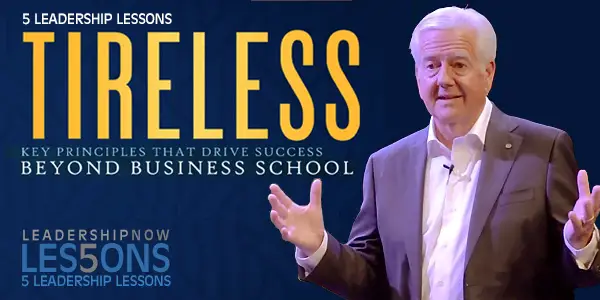
YOUR NEXT DECISION could dictate the trajectory you take. In Tireless, Kim Lorenz encourages us to look for opportunities both as an entrepreneur and in the company where we work, that will propel us to success. Lorenz co-founded two companies that he eventually sold to Fortune 500’s. He shares his experiences and those of others to give us a picture of the principles that bring success and the mindset required to see the opportunities in front of us. Here are five thoughts from Kim Lorenz:

Posted by Michael McKinney at 07:45 PM
03.09.20

5 Leadership Lessons: Built Not Born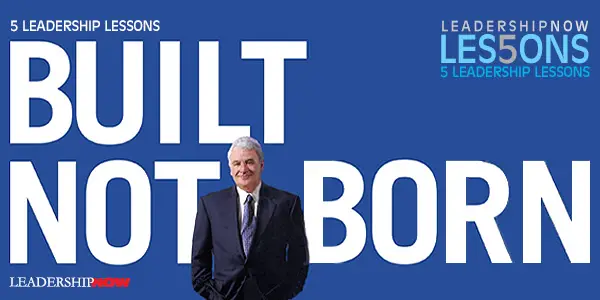
IF you are considering starting your own business or struggling to get one off the ground, Tom Golisano’s Built Not Born will be very valuable. Entrepreneurship is not easy, but it can be rewarding, provided you keep some basic business principles in mind. With $3000 and a credit card in hand, Tom Golisano started what has become today the multi-billion-dollar Paychex. Golisano takes us through what he experienced from start to finish, what not to forget, and what the business owner is responsible for and the importance of understanding every aspect of your business. Much of the advice is obvious, but in the thick of running a business, all too easy to forget. And Golisano keeps the critical issues front and center. “Running a business, any business, means challenges, some expected and others that come out of the blue. It comes with the territory. It’s an old aphorism, but it’s true nevertheless: If you can’t stand the heat, get out of the kitchen.” While entrepreneurship is not for everyone, going in well-informed is essential to success.
Always keep in mind, a lasting legacy is built on we, not I. 
Posted by Michael McKinney at 08:02 AM
03.06.20

Culture Makes the Difference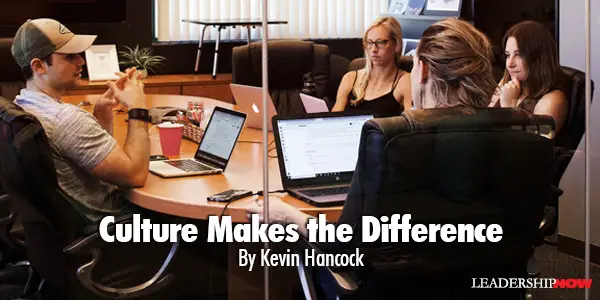
WHAT differentiates companies? It’s generally not products, services, facilities, or equipment. In our industry, for example, our lumberyard competitors sell essentially the same assortment of building materials that we do. Across New England, our white pine sawmill competitors make products that are very similar to our own. Additionally, we all tend to sell our products at comparable prices. So, what differentiates one company from another? Years ago, I would have said it was people who make the difference and separate companies. But I have come to realize that’s not the whole story. Certain companies may think they have the "best people," but the truth is, great people are everywhere—the planet is filled with them. For example, the United States has a more productive economy per capita than Europe, but no one would take this to mean that America has better people than Europe does. America is filled with great people, and so is Europe—and, so is every other country on earth. People are inherently great by virtue of their common humanity. So, if products don’t make the difference, and great people are everywhere, then what separates one organization from another? The answer is culture. Culture makes the difference. An organization’s culture either creates an environment where great people can flourish, or an environment where people are frustrated, held back, or stymied. What makes one corporate culture different from another? To me, it’s all about control and where it lives. Some organizations collect leadership power into the bureaucratic center, where a few people can make the majority of the decisions for the many. This is the traditional model of business—and government—leadership and, during a period of time in human history, this may have been optimal. But, that time has passed. In the 21st century, organizations that disperse power, share leadership, and give everyone a voice are going to win because they recognize and celebrate the capabilities of everyone on the team. These types of cultures don’t see employees as expendable commodities whose purpose is to serve the company. In fact, these types of cultures flip the traditional script by recognizing that the company exists to serve the people who work there. In a great company, profit is an outcome of a higher calling. That higher calling is the celebration of the human spirit and human capacity. In this way, culture makes all the difference. This is why culture is so important to us at Hancock Lumber. We want our company to be a place where every person on the team is trusted, valued, respected, and heard. Work should serve the people who do it in more than just economic ways. Work should be a place where humans flourish—where people learn, lead, and grow. If the employees of a company have an exceptional experience, they will ensure that customers thrive and will protect and grow their company with loyalty and pride. Culture, it turns out, makes the difference. Great people are everywhere, but great cultures aren’t – that’s what separates one company from another.  
Posted by Michael McKinney at 02:27 PM
03.05.20

Leading Thoughts for March 5, 2020
IDEAS shared have the power to expand perspectives, change thinking, and move lives. Here are two ideas for the curious mind to engage with: Robert E. Quinn on the connection between changing a system and understanding it: “Kurt Lewin argued that we cannot really begin to understand a system until we try to change it. He understood that individual as well as collective scripts would stay hidden until the normal way that the organization operates is challenged. As soon as a change agent introduces a variation to that system, he or she will quickly learn about the scripts that are holding that system together. Once the scripts are brought to the light they tell us a lot about how that system handles variations.” Source: Change the World: How Ordinary People Can Accomplish Extraordinary Results Change consultant David Jones on the challenges to expect when initiating change: “Once you get past the novelty of a change, you’ll find that every system in your organization is set up to reject it. You’ve got to have the resolve, the courage, and the fortitude to see change through that part of the process, because it’s the most difficult part of the transition. You’ll only accomplish that if you’re able to successfully communicate why you’re changing, how it will be measured, why it is critical, and why people need to get on board and make it successful. It’s easy to get out of touch with the emotions of the people most affected by change.” Source: Decade of Change: Managing in Times of Uncertainty Look for these ideas every Thursday on the Leading Blog. Find more ideas on the LeadingThoughts index.
Posted by Michael McKinney at 09:21 AM
03.04.20

Are You Leading for the Right Reasons?
YOU either lead for yourself or others. Why you took the role you now fill, affects the results you are getting. Patrick Lencioni has penned another leadership fable that follows the discussion of two CEOs getting to the bottom of why they lead and the results they are getting from their two different mindsets. The Motive is classic Lencioni, with plenty of let’s-get to the-core-of-the-issue insights. He writes that there are fundamentally only two motives that drive people to lead: service or reward. Those who lead to serve “understand that sacrifice and suffering are inevitable in this pursuit and that serving others is the only valid motivation for leadership. Those who lead for rewards often associated with leadership “see leadership as the prize for years of hard work and are drawn by its trappings: attention, status, power, money.” When leaders are motivated by personal reward, they will avoid the unpleasant situations and activities that leadership requires. They will calculate the personal economics of uncomfortable and tedious responsibilities—responsibilities that only a leader can do—and try to avoid them. This inevitably leaves the people in their charge without direction, guidance, and protection, which eventually hurts those people and the organization as a whole. Employees will express their disbelief as to how their leader could have been so negligent and irresponsible, yet it makes perfect sense in light of his or her motive for becoming a leader. Lencioni acknowledges that although we all try to do the right thing at times, we do fall short. But a little self-examination will reveal that one of these motivations is predominant in our thinking and explain the impact we’re having on the health of the entire organization. What Do Reward-Centered Leaders Avoid? When you are motivated by reward as a leader, you typically avoid these five situations or responsibilities: 1. Developing the Leadership Team In some cases, leaders delegate team-building to their head of HR. Let me be very clear; this does not work. And that’s not a knock against HR folks. If people on a leadership team don’t believe that the leader sees team development as one of his or her most critical roles, they’re not going to take it seriously, and it’s not going to be effective. The leader simply must take personal responsibility for, and participate actively in, the task of building his or her team. 2. Managing Subordinates (And Making Them Manage Theirs) Managing individuals is about helping them set the general direction of their work, ensuring that it is aligned with and understood by their peers, and staying informed enough to identify potential obstacles and problems as early as possible. It is also about coaching leaders to improve themselves behaviorally to make it more likely that they will succeed. 3. Having Difficult and Uncomfortable Conversations Failing to confront people quickly about small issues is a guarantee that they will become big issues. And if you’re not a responsibility-centered leader, one who understands that if the leader doesn’t do it, no one will, then you’re probably going to find a reason, almost any reason, to ignore those messy issues and do something else. 4. Running Great Team Meetings Meetings are the setting, the arena, the moment when the most important discussions and decisions take place. What could be more important? 5. Communicating Constantly and Repeatedly to Employees Most CEOs don’t hate the idea of communicating to employees. But the majority of them greatly underestimate the amount of communication that is necessary…. Unfortunately, many CEOs refuse to repeat themselves again and again and again and again…. No reasonable human being has ever left a company because management communicated too much. “That’s it. I’m going somewhere where leaders tell me something once and never repeat it again!” Each of these points ends with a section of questions “to help you reflect on your own attitude and discern whether you may be struggling to some extent with reward-centered leadership.” What motivates us to lead? If it is not service, we aren’t really leading; we are simply draining the organization and its people for our own gain. Lencioni encourages “those who chose to embrace responsibility-centered leadership—even if they were formerly focused on rewards—will come to see activities and situations that they once viewed as tedious and unpleasant as the real work of a selfless leader. And eventually, start to enjoy them.” But more than that, we are teaching future generations that the only kind of leadership that matters is responsibility-based or service-centered leadership. If reward-centered leadership is the norm, “the wrong people will aspire to be managers, CEOs, and civic leaders, condemning society to more of the same or generations to come.” The cost is too high. 
Posted by Michael McKinney at 12:00 AM
03.02.20

10 Lessons from Porter Moser’s All In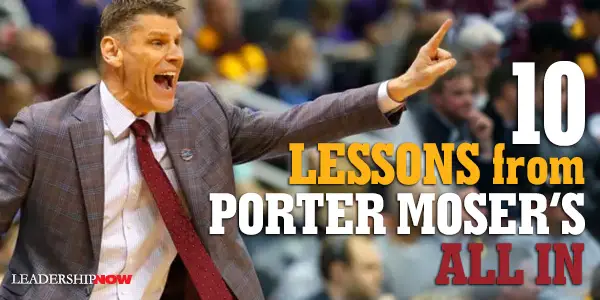
PORTER MOSER is the head men's basketball coach at Loyola University Chicago. Known for what he does on the court, he has guided the Loyola-Chicago Ramblers to three post-season berths, including a historic run to the 2018 NCAA Final Four and back-to-back MCV regular-season championships in 2018 and 2019. But it is his reputation and impact for what he does developing people off the court that is his legacy. In All In: Driven by Passion, Energy, and Purpose, he shares the values and beliefs, the ups and downs of his career, and the lessons he has taken from them. All In is filled with wisdom and lessons from a life leading others to their potential. I’ve extracted some of them for our mutual benefit:

Posted by Michael McKinney at 03:36 PM
03.01.20

First Look: Leadership Books for March 2020Here's a look at some of the best leadership books to be released in March 2020. Don't miss out on other great new and future releases.
Everyone has something they want to change. Marketers want to change their customers’ minds and leaders want to change organizations. Start-ups want to change industries and nonprofits want to change the world. But change is hard. Often, we persuade and pressure and push, but nothing moves. Could there be a better way? This book takes a different approach. Successful change agents know it’s not about pushing harder, or providing more information, it’s about being a catalyst. Catalysts remove roadblocks and reduce the barriers to change. Instead of asking, “How could I change someone’s mind?” they ask a different question: “Why haven’t they changed already? What’s stopping them?”
So often in life, we get stuck in a cycle of response. We put out fires. We deal with emergencies. We stay downstream, handling one problem after another, but we never make our way upstream to fix the systems that caused the problems. Cops chase robbers, doctors treat patients with chronic illnesses, and call-center reps address customer complaints. But many crimes, chronic illnesses, and customer complaints are preventable. So why do our efforts skew so heavily toward reaction rather than prevention? Upstream probes the psychological forces that push us downstream—including “problem blindness,” which can leave us oblivious to serious problems in our midst.
Workers want and need to know their work is appreciated. Showing gratitude to employees is the easiest, fastest, most inexpensive way to boost performance. New research shows that gratitude boosts employee engagement, reduces turnover, and leads team members to express more gratitude to one another—strengthening team bonds. Studies have also shown that gratitude is beneficial for those expressing it and is one of the most powerful variables in predicting a person’s overall well-being—above money, health, and optimism.
In 1984, Doug Conant was fired without warning and with barely an explanation. He felt hopeless and stuck but, surprisingly, this defeating turn of events turned out to be the best thing that ever happened to him. Doug began to consider what might be holding him back from realizing his potential, fulfilling his dreams, and making a bigger impact on the world around him. Embarking on a journey of self-reflection and discovery, he forged a path to revolutionize his leadership and transform his career trajectory. Ultimately, Doug was able to condense his remarkable leadership story into six practical steps. It wasn't until Doug worked through these six steps that he was able to lift his leadership to heights that ultimately brought him career success, joy, and fulfillment.
Parents in today's fast-paced, disorienting world can easily lose track of who they are and what really matters most. But it doesn't have to be this way. As a parent, you can harness the powerful science of leadership in order to thrive in all aspects of your life. Drawing on the principles of his book Total Leadership—a bestseller and popular leadership development program used in organizations worldwide--and on their experience as researchers, educators, consultants, coaches, and parents, Stew Friedman and coauthor Alyssa Westring offer a robust, proven method that will help you gain a greater sense of purpose and control.
What potential is so close within your grasp? What are you actually capable of? Create the Future teaches you how to think disruptively, providing specific steps to create real innovation and change. It combines Jeremy's high energy provocative thinking with tactics that have been battle tested through projects with leading innovators like Disney, Starbucks, Amex, IBM, Adidas, Google, and NASA. Better yet, this is a double-sided book. Create the Future is paired with a revised edition of Jeremy's award-winning innovation handbook, Exploiting Chaos.
 Build your leadership library with these specials on over 39 titles. All titles are at least 40% off the list price and are available only in limited quantities. “There is more treasure in books than in all the pirate’s loot on Treasure Island.” — Walt Disney
Posted by Michael McKinney at 11:37 AM
|
BUILD YOUR KNOWLEDGE


How to Do Your Start-Up Right STRAIGHT TALK FOR START-UPS 
Grow Your Leadership Skills NEW AND UPCOMING LEADERSHIP BOOKS 
Leadership Minute BITE-SIZE CONCEPTS YOU CAN CHEW ON 
Classic Leadership Books BOOKS TO READ BEFORE YOU LEAD |
|